AI at Work
7 Facebook Ad Examples You Can Recreate with AI Ad Generator on Typeface

Akshita Sharma · Content Marketing Associate
March 31st, 2025 · 23 min read

While new social platforms come and go, Facebook remains the top choice for marketing and advertising, with over 80% of marketers preferring it. Recent Pew Research data shows that Facebook is where most Americans come to consume news and make critical purchasing decisions—outperforming platforms like YouTube, Instagram, and TikTok.
Over the past decade, Facebook has evolved from a simple display advertising channel into a sophisticated multi-channel ecosystem. Brands looking to maximize their advertising efforts on Facebook now need to maintain consistent presence across Facebook Marketplace, Messenger, and Stories. This expansion creates a complex challenge: How do you scale creative production across these channels while maintaining brand consistency, creative quality, and the personalization that customers expect?
This is exactly what an AI ad generator is designed to do. At Typeface, we've seen firsthand how an AI ad generator is changing the way brands approach Facebook advertising. Instead of having to choose between scale and personalization, our AI ad generator enables marketing teams to achieve both, producing tailored, high-impact ad creatives at a pace that matches today's digital demands. In this guide, we'll show you how to use an AI ad generator to recreate successful Facebook ad campaigns.
Challenges marketers face in Facebook ad creation
Facebook ad examples for inspiration
How to use Typeface for Facebook ad generation
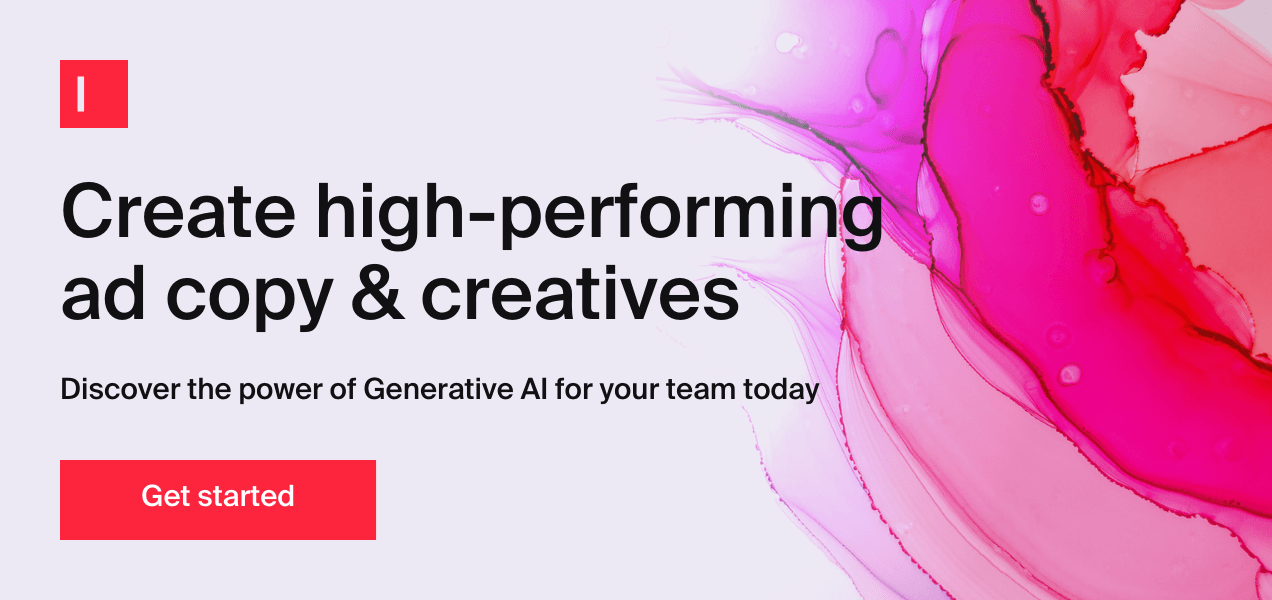
Challenges marketers face in Facebook ad creation
Marketers advertising on Facebook face many challenges that directly impact ROI and campaign performance. Take ad fatigue – a phenomenon that affects 59% of consumers and can derail even the most meticulously planned ad campaigns. When a user encounters your ad for the fourteenth time in their feed, they don't just ignore it – their brain actively filters it out. This "banner blindness" transforms your ad spend into digital wallpaper.
This is what happened with Spotify's "Switch to Premium" ad campaign. Initially clever, the repetitive messaging became so persistent that many users reported tuning out their messages entirely.
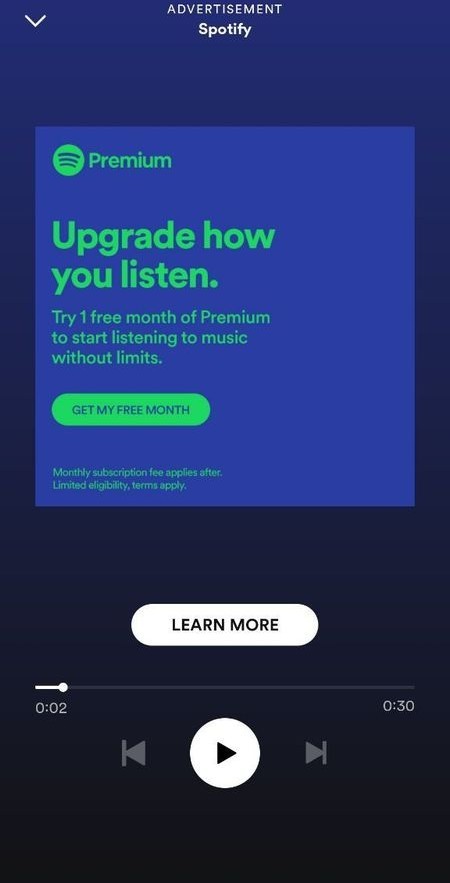
Facebook's ad restrictions present another layer of complexity. There are protocols for advertising on the platform that can trigger automated rejections if not properly followed. Such rejections can negatively affect an advertiser's account standing, potentially leading to limited functionality or even suspension from advertising on the platform altogether.
These challenges compound when you have to maintain brand consistency across markets while personalizing ad content. Marketing teams must manage vast libraries of brand assets while ensuring each ad variant adheres to both audience preferences and brand guidelines. This complexity often results in campaign launch delays and significant overhead costs.
The solution: an AI ad generator
Typeface's AI ad generator addresses these challenges in the following ways:
Dynamic content generation to combat ad fatigue: Instead of manually generating headlines, copy and visuals, marketers can leverage Typeface's AI templates and Ad Agent to instantly produce dozens of ad variations. This means that you can always keep your content fresh and engaging and maintain user interest, without exhausting your creative resources.
Creates hyper-targeted ads by tapping into granular audience insights: Typeface excels at creating highly relevant and personalized ads for your target customers. You can set up audience profiles on the platform and then apply them to the AI during content generation. This allows the AI to craft messages that resonate more deeply, leading to higher engagement rates and better overall performance.
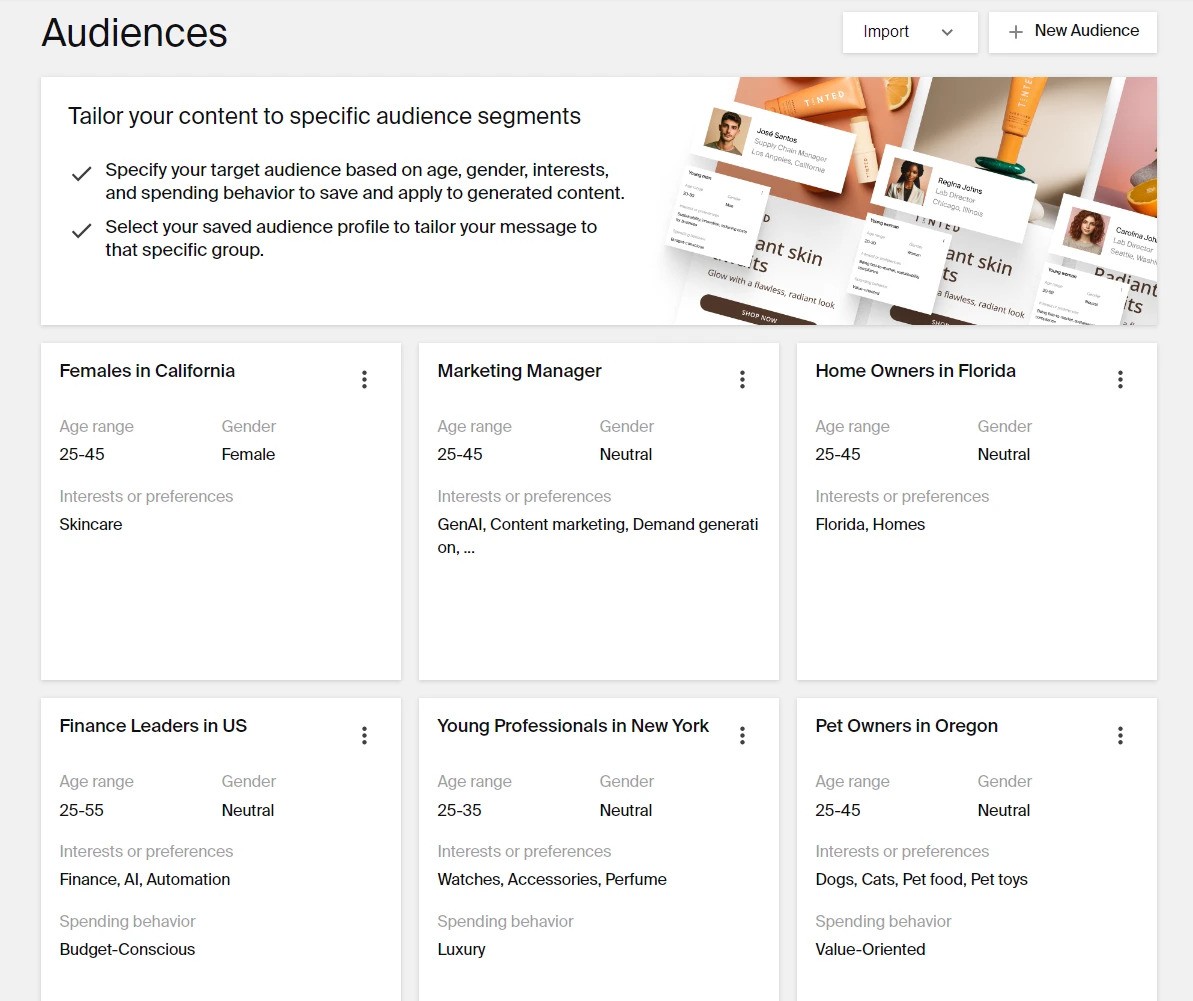
Streamlines multi-channel deployment through Ad Agent : When you need to adapt a Facebook ad for other platforms and markets, Typeface’s Ad Agent automatically reformats your creatives while preserving key design elements. This eliminates the tedious process of manual resizing and ensures consistent branding across every channel.
Simplifies ad experimentation: By helping you quickly produce multiple ad variations, Typeface allows you to A/B test different elements like headlines, descriptions, calls to action, and visuals. This makes it easier to identify winning combinations that drive measurable improvements in click-through and conversion rates.
While basic AI social media ad generator tools promise to automate copywriting, Typeface delivers an enterprise-grade AI solution that addresses the full complexity of modern advertising operations. Let's say your team needs to create 100 ad variations for a product launch, each tailored to specific market segments across 15 countries, while maintaining strict brand compliance and regulatory requirements. Traditional AI tools would require endless manual intervention – copying and pasting generated content, reformatting visuals, and manually checking brand guidelines. Typeface, in contrast, integrates directly with your existing MarTech stack to automate this entire process. It pulls audience data from your CDP, applies brand guidelines, and pushes finished creative directly to ad platforms, reducing what would typically be a two-week process down to hours.
The platform's architecture addresses the sophisticated needs that basic AI generators ignore. For instance, its multimodal AI doesn't just generate isolated assets – it understands the interplay between text and visual elements, ensuring your Facebook ad's imagery naturally flows with its copy.
Your marketing team gets the controls they need: granular brand governance settings, built-in compliance checks, and the ability to generate content at scale while maintaining consistent brand voice across all touchpoints. For enterprise marketing teams juggling multiple brands, products, and markets, this level of intelligent automation transforms how ad campaigns are conceived, created, and optimized.
With that, let’s take a look at some Facebook ad examples and identify strategies that you can implement in your own campaigns.
Facebook ad examples for inspiration
If you're looking for some inspiration for your next Facebook ad campaign, we've picked out some Facebook ad examples that showcase proven strategies from leading brands:
1. Single-image Facebook ad examples
A single image ad is the simplest type of ad format, perfectly suited for content that delivers a clear message through a single photo. Typically, these ads include just one image alongside a headline, a brief description, and a call-to-action button that leads viewers to a specific website or landing page. They're easy to create and engage with, making them perfect for straightforward messages or promotions. Plus, single image ads often load quickly and are cost-effective, helping you maximize reach and ROI, especially if you're working within a tight advertising budget.
Key elements of an effective single image ad:
Strong visuals: For single image ads, choose a resolution of 1080 x 1080 pixels for square images and 1200 x 628 pixels for landscape. Make sure that the image is relevant to the ad campaign. When adding text, make sure it doesn’t block the visuals. Opt for a clean font with a size and color that stands out. Consider featuring people using your product or service to help viewers imagine themselves doing the same.
Concise message: Single image ads are best for conveying a simple, straightforward message. Keep text concise and readable on mobile devices. Recommended text length is 90 characters for the text, 25 characters for the headline, and 30 characters for the link description.
Mobile optimization: Test different aspect ratios, such as square or vertical, and ensure the call-to-action is clear and easy to tap on smaller screens. Vertical 4:5 is recommended for single-image ads to be delivered to the Facebook Feed.
Here are two noteworthy Facebook ad examples of a single-image ad.
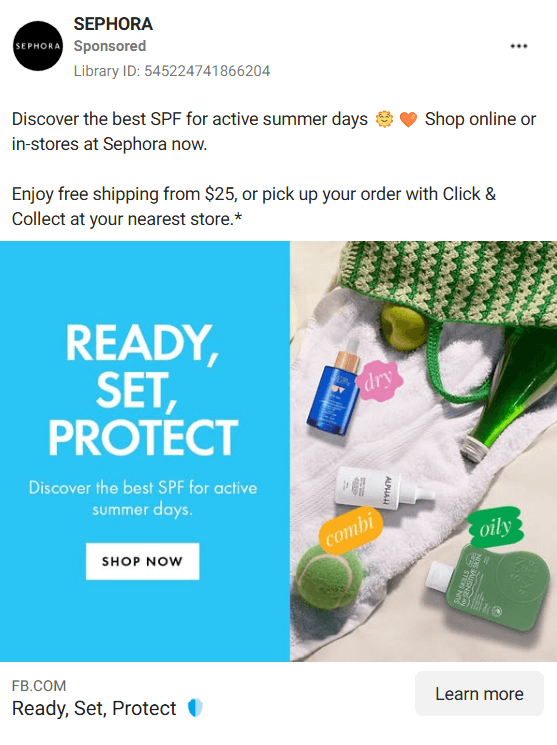
What we like:
Visually appealing: The beach-themed image instantly connects with the target audience, highlighting the importance of SPF during summer. The variety of sunscreen products showcased for different skin types (dry, combi, oily) makes the ad relatable while providing practical information.
The bold text overlay doesn't distract: The "READY, SET, PROTECT" text is attention-grabbing without covering the entire image. The clean, modern font maintains readability while adhering to Facebook's preference for minimal text overlay.
Concise and benefit-driven copy: The headline directly addresses the seasonal need while the secondary text highlights immediate value with "free shipping from $25" and "Click & Collect" options, removing purchase barriers.
Clear CTA: The prominent "Shop Now" and "Learn More" buttons leave no question about what the user should do next.
Mobile-friendly design: The square format optimizes screen space on mobile devices, while the clean layout and easily digestible content ensure a good user experience across devices.
Audience segmentation: The labeled products for different skin types (dry, combi, oily) cleverly address various customer needs in one visual, broadening appeal.

What we like:
Clean and inviting visual: The image features a well-lit, styled bedroom scene that showcases the bedding and furniture, creating an aspirational yet attainable aesthetic for audiences. The neutral color palette and minimalist design align with IKEA's brand.
Good use of white space: There is a lot of white space that helps avoid a cluttered feeling and creates a calm atmosphere that reinforces the sleep theme.
Clear promotion: The offer, "15% off All mattresses, pillows, and bedding" is clearly communicated, both in the copy and the image, ensuring the value proposition is immediately understood.
Sense of urgency: The ad mentions the "IKEA sleep event!" with a date which gives users a sense of urgency, since they know the promotion has an expiration date.
Brand recognition: IKEA's logo is prominently displayed in the upper left corner, ensuring immediate brand recognition.
Loyalty emphasis: The "IKEA Family offer" callout highlights the benefit of membership, encouraging both current members to take action and non-members to consider joining.
Mobile-optimized format: The portrait-style image works well in mobile feeds, where most Facebook users will encounter the ad.
2. Facebook carousel ad examples
A Facebook carousel ad is an ad format that allows you to display multiple images or videos (up to ten) within a single ad, each with its own headline, description, link, and CTA. Carousel ads are known for boosting engagement and click-through rates, making them a cost-effective option for retargeting audiences or telling your brand's story.
Key elements of an effective carousel ad:
Compelling visuals: The initial image should be striking enough to make viewers want to continue looking. You can also try a combination of static images and videos.
Focused narrative: Carousel ads can tell a story or explain a process in a step-by-step guide using images or short videos. For these typeface of Facebook ads, each carousel card should connect to each other under one creative concept.
Clear call to action: Carousel ads allows up to ten CTAs, so you can guide users to take different steps on each card. CTAs should be action-oriented and lead to a relevant landing page.
Strategic card ordering: Place your strongest performing image first to capture attention, but ensure all cards can stand on their own if viewers don't swipe through the entire carousel.
Mobile optimization: Design with mobile users in mind - use high-contrast images and readable text since approximately 98% of Facebook users access the platform via mobile devices.
Ideal image specifications: Use 1080 x 1080 pixels for square images with a 1:1 aspect ratio for optimal display across devices.
Product showcasing: For e-commerce, feature different products or different angles of the same product to provide comprehensive information that drives purchasing decisions.
Here are two noteworthy Facebook ad examples of a carousel ad.
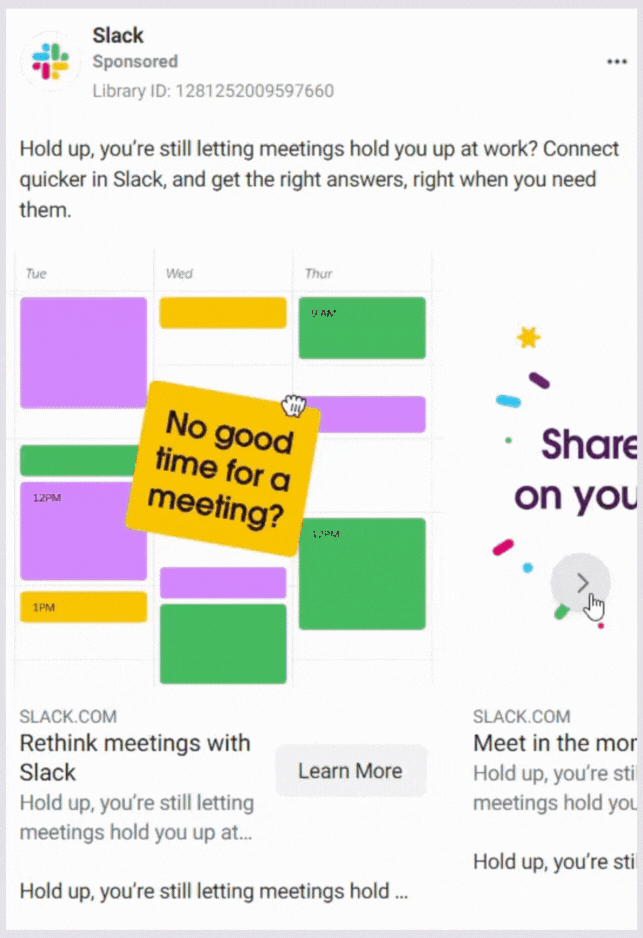
What we like:
Logical flow: Each carousel card represents a distinct stage of the message, ensuring that users receive bite-sized information in a logical sequence. The opening card immediately addresses a common pain point—time-consuming meetings. The next card presents a solution by showing how Slack enables asynchronous communication. A feature-focused approach makes the benefits of using Slack tangible, showing users exactly how the product can replace meetings.
Emphasis on key visuals: The ad ensures that important elements—like the product images, branding, or offers—are visually distinct in each section. These compelling visuals encourage viewers to continue swiping through the entire carousel, maximizing engagement.
Consistent branding and messaging: The smooth transitions help maintain a cohesive visual identity, reinforcing the brand while keeping the content fresh. This is crucial for carousel ads, where each card should feel connected but offer new value. This visual consistency across cards creates a professional, unified experience that builds brand recognition.
Encouraging user action: The text overlays in each carousel guide the viewer toward a next step, ending with a clear, action-oriented CTA, asking users to "Get Started." This strategic use of CTAs follows best practices by guiding users through a conversion funnel across multiple cards.
Strategic card sequence: The carousel begins with the most attention-grabbing pain point to hook viewers, then logically progresses through solution and benefits before ending with action—following the recommended practice of leading with your strongest content.
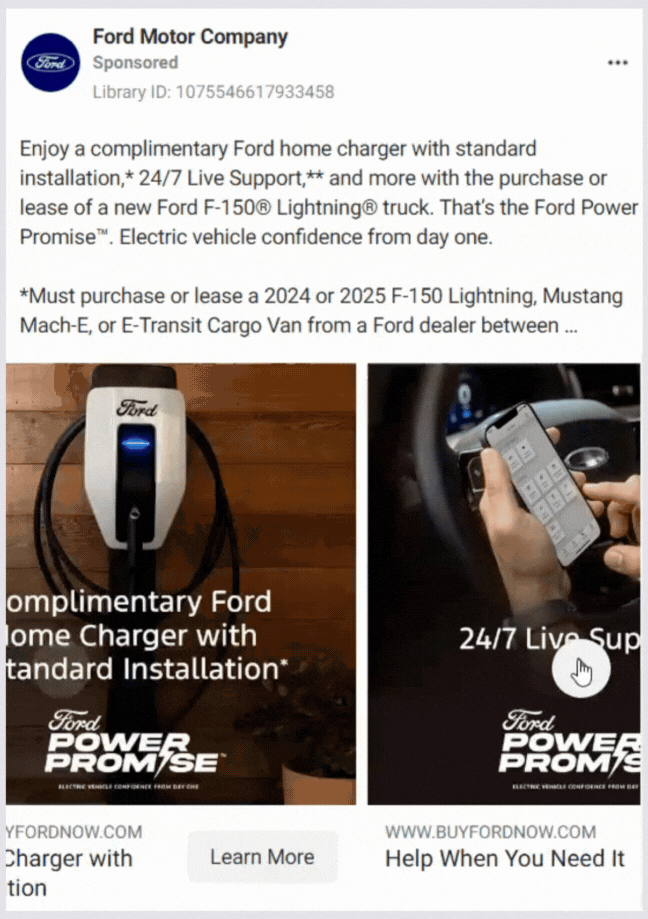
What we like:
Clear value proposition: Each card in this carousel ad reinforces Ford’s Power Promise, offering a range of incentives on purchasing Ford electric vehicles. This makes the ad compelling by addressing potential concerns about EV ownership.
Feature-driven messaging: Each carousel card highlights a different selling point—home charger, live support, and financing options—ensuring that users see multiple benefits in a structured way.
Use of iconography: The carousel ad incorporates simple yet effective images to represent features like home charging and 24/7 support. This helps communicate key benefits quickly without relying on long blocks of text.
Consistent branding: The ad maintains uniform colors, fonts, and messaging across all cards, ensuring strong brand recall and reinforcing trust in Ford's EV commitment. This visual consistency across the carousel creates a cohesive experience that strengthens brand identity while allowing each card to stand independently.
Strong call-to-action: The "Learn More" CTA is placed prominently on every card, making it easy for users to take the next step without needing to search for additional details.
Product differentiation: Each card contributes to distinguishing Ford's EV offerings in a competitive market, leveraging the carousel format to showcase multiple competitive advantages that wouldn't fit effectively in a single image ad.
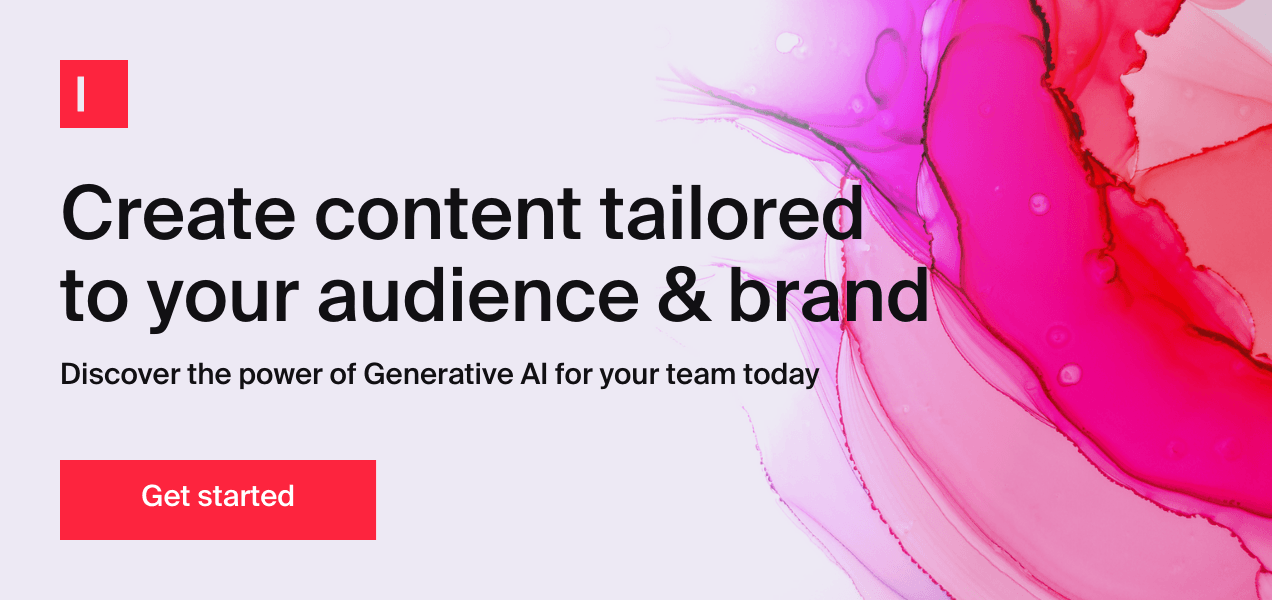
3. Facebook collection ad example
Facebook Collection Ads are a mobile-only ad format designed to provide an immersive shopping experience for users. These ads are great for driving product discovery and sales by allowing users to browse a collection of products directly within the ad.
Key elements of an effective Facebook collection ad:
Visual format: Collection Ads feature a slide of images, or a cover image accompanied by four product images displayed underneath.
Instant experience: When users click on a Collection Ad, they are taken to a full-screen Instant Experience within Facebook, where they can browse a curated selection of products. This eliminates the need to leave the Facebook or Instagram app to learn more about the ad offer.
Mobile-optimized: This ad format is specifically designed for mobile users, aiming to capture their attention and provide a fast-loading experience.
High-quality cover image: The cover image should be visually striking and relevant to your product offerings. Ideally use 1080 x 1080 pixels for square images or 1080 x 600 pixels for rectangular images.
Product selection strategy: Carefully curate the products shown beneath the cover image to represent bestsellers or items that complement each other, encouraging multiple purchases.
Clear price visibility: Make sure prices are clearly visible on product images to set proper expectations and qualify interested shoppers.
Consistent product photography: Maintain consistent product photography style, lighting, and backgrounds to create a professional, cohesive appearance.
Here is an example of a Facebook collection ad.
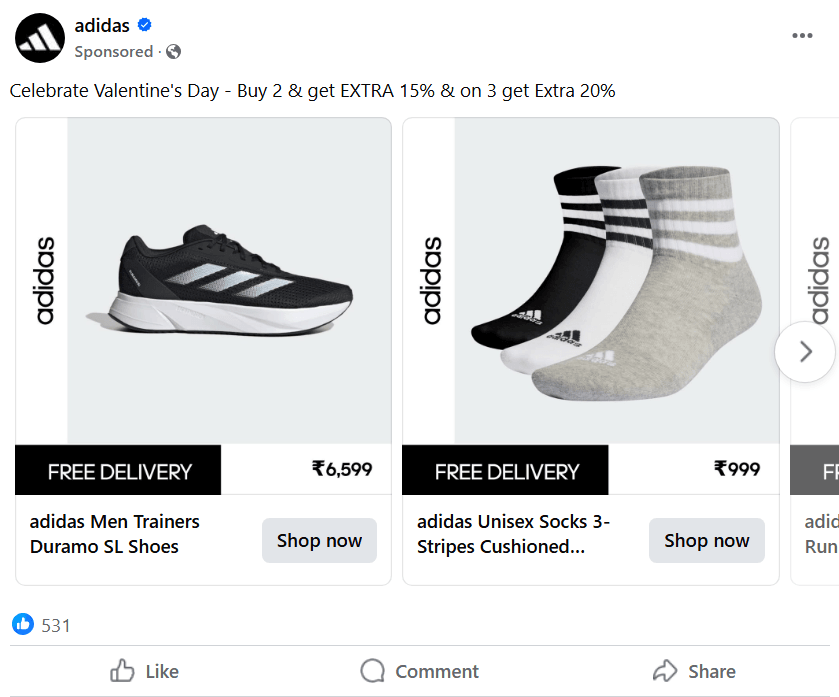
What we like:
Clear product focus: The ad prominently showcases Adidas products with high-quality images. This allows users to quickly see what's being offered.
Clean design: The ad uses a clean, uncluttered design with a white background, which helps the products stand out. The Adidas branding is visible but not overwhelming,. yet consistently reinforced with logo placement on both product cards and the vertical branding along the sides.
Value Proposition: The "Celebrate Valentine's Day" message combined with the discount offer provides a clear incentive for purchase. This leverages a timely theme to drive sales.
Key information displayed: Each product listing includes essential details like product name, price, and CTA, plus the "FREE DELIVERY" benefit is prominently highlighted to remove a common purchase barrier.
Mobile-friendly: The layout is designed to be easily viewed and interacted with on mobile devices, which is crucial for Facebook collection ads with appropriately sized tap targets for the "Shop now" buttons.
Action-oriented CTAs: The "Shop now" buttons are clear and encourage users to take immediate action with consistent placement across product cards for a predictable user experience.
Complementary product selection: The collection strategically pairs products that might be purchased together (shoes and socks), encouraging users to meet the minimum threshold for the advertised discount.
4. Facebook video ad examples
Facebook video ads allow you to highlight a product, service, or brand through engaging video content. You can create these ads using Meta Ads Manager or by boosting a Facebook page post featuring a video. They can help you showcase a product in use, tell a compelling brand story, or deliver a straightforward message that encourages viewers to take action.
Key elements of a good Facebook video ad:
Engaging narrative: These Facebook ads should engage viewers within the first 2-3 seconds using striking visuals, a captivating slogan, or an intriguing question.
Short video length: Aim for a video length of around 30 seconds to maintain viewer interest and avoid disrupting their experience.
Ensure the video makes sense without sound: Design the video to be effective even when muted by using subtitles and compelling visuals. Most Facebook videos are watched without sound.
Storytelling: The video should have a relatable and engaging narrative that presents your product or service as a solution.
Clear CTA: Use a call-to-action button to encourage viewers to take a specific action, such as visiting a website or making a purchase.
Mobile-first approach: Design videos in vertical (9:16) or square (1:1) format for optimal mobile viewing, as over 94% of Facebook users access the platform via mobile devices.
Thumbnail optimization: Create a compelling thumbnail image that entices users to click play, as this is often the first element viewers notice in their feed.
Captions and accessibility: Include accurate closed captions or burned-in subtitles to improve accessibility and engagement with sound-off viewers.
Quality over production value: Focus on clear messaging and relevance over high production costs—authentic content often outperforms overly polished videos on social platforms.
Here are two noteworthy Facebook ad examples of a video ad.
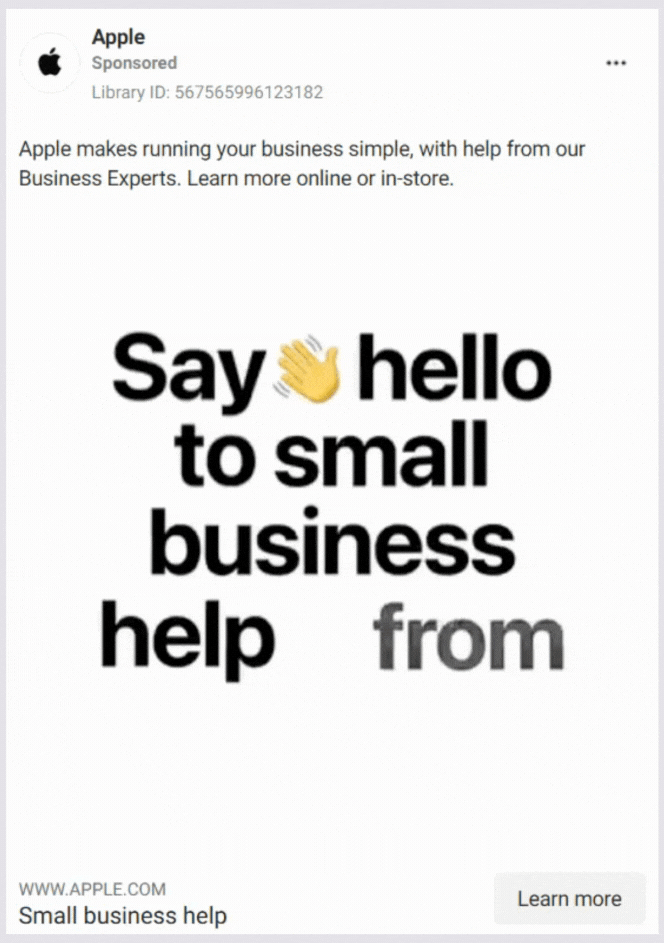
What we like:
Concise and impactful messaging: The video keeps the message within 4.5 seconds, making it highly effective for short attention spans on Facebook.
On-screen text: The use of on-screen text in this video ad ensures that the message is delivered effectively, even when it is played without sound. The ad maintains its impact and the brand’s message is consistently delivered, regardless of how it's being viewed.
Clear CTA: The ad concludes with a strong CTA ("Learn More"), directing viewers to Apple's website, encouraging deeper engagement.
Brand consistency: The video maintains Apple's signature minimalist aesthetic and clean design language, instantly recognizable to viewers familiar with the brand.
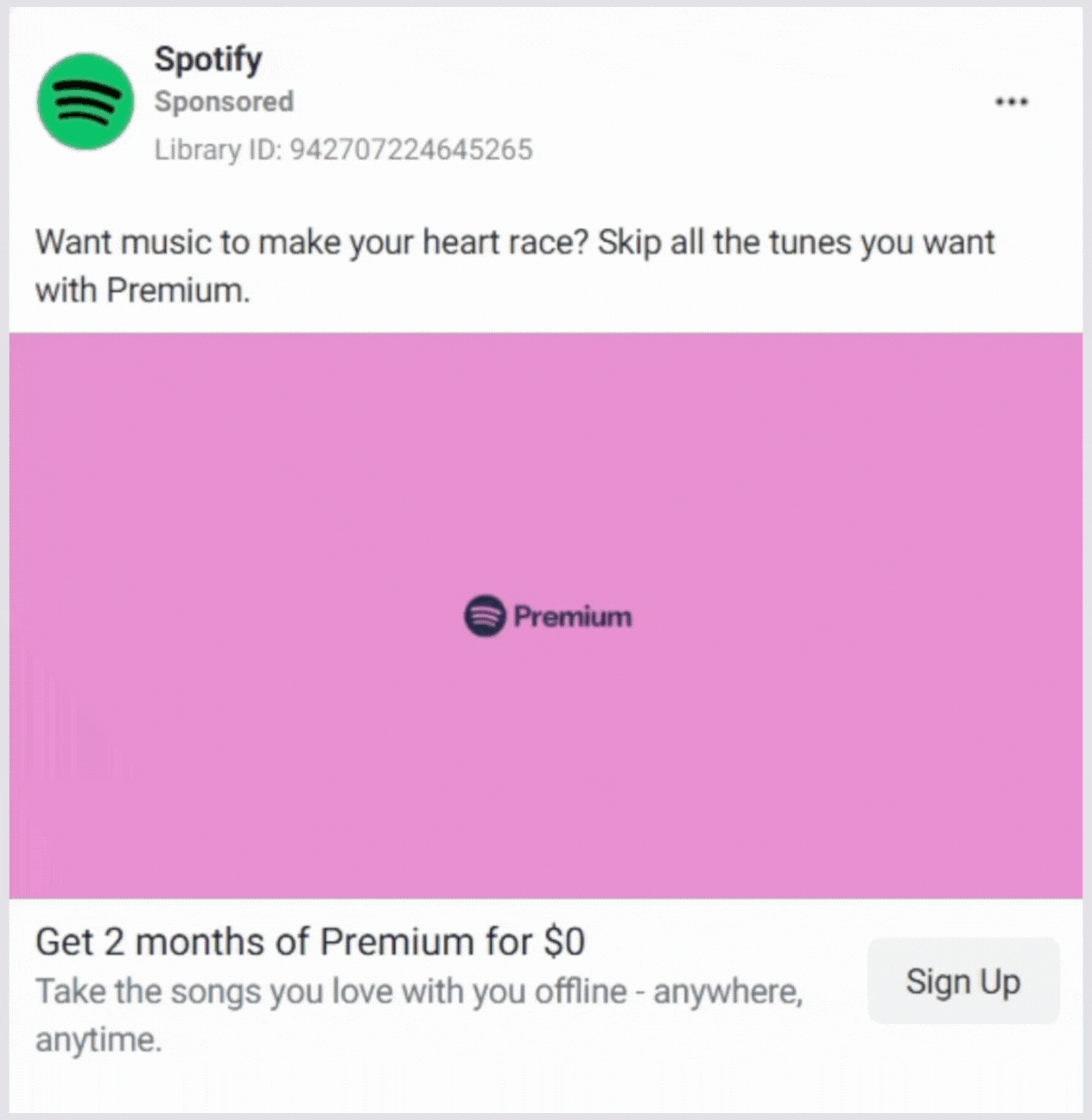
What we like:
Strong promotional offer: The value proposition of “Get 2 months of premium at $0” makes the ad more compelling for conversions.
Emotion-driven messaging: The body copy, “Want music to make your heart race? Skip all the tunes you want,” appeals to the listener’s emotions and highlights a key feature (unlimited skips).
Visual flow: The video has no abrupt scene changes, ensuring a smooth, immersive experience for the viewer.
Consistent branding: The color palette and typography align with Spotify’s signature look, reinforcing brand identity.
Clear call-to-action: The "Sign Up" button provides a direct next step, making it easy for users to act immediately.
Sound-off optimization: The visual storytelling works effectively without audio, ensuring the message remains clear for the majority of Facebook users who watch without sound.
How to use Typeface for Facebook ad generation
Having explored some examples of Facebook ads, let's examine a few ways that Typeface makes generating Facebook ads more efficient.
Generating a creative brief for Facebook ad campaigns
When working with a team of marketers or copywriters, a creative brief is usually needed for every ad campaign. Unfortunately, this step is often overlooked because it can be time-consuming and demanding. Fortunately, AI can assist by swiftly generating detailed creative briefs, highlighting the main requirements, message, and goal for each ad campaign.
To generate these briefs on Typeface, all you need to do is provide a few inputs in the Creative Brief template, like your ad campaign description and the goal of the brief.
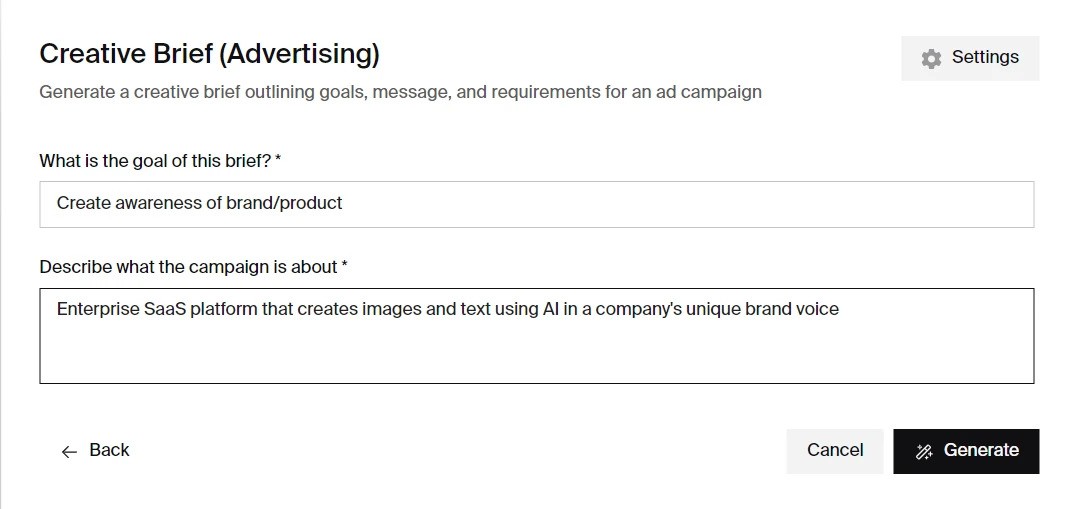
The AI will generate a creative brief for your ad campaign, covering timeline, budget, KPIs, metrics, and more. You can even guide the AI to incorporate target keywords and other essential details in the brief.

Typeface also lets you seamlessly integrate your existing content libraries into the platform. By doing so, you can enrich your creative brief with additional context and resources, making it even more precise and relevant for both your team and the specific project you're working on.
Creating Facebook ads with Meta Ad template
For creating the Facebook ad copy and visuals, Typeface offers a Meta Ad template that seamlessly adapts content across Meta's entire advertising ecosystem.
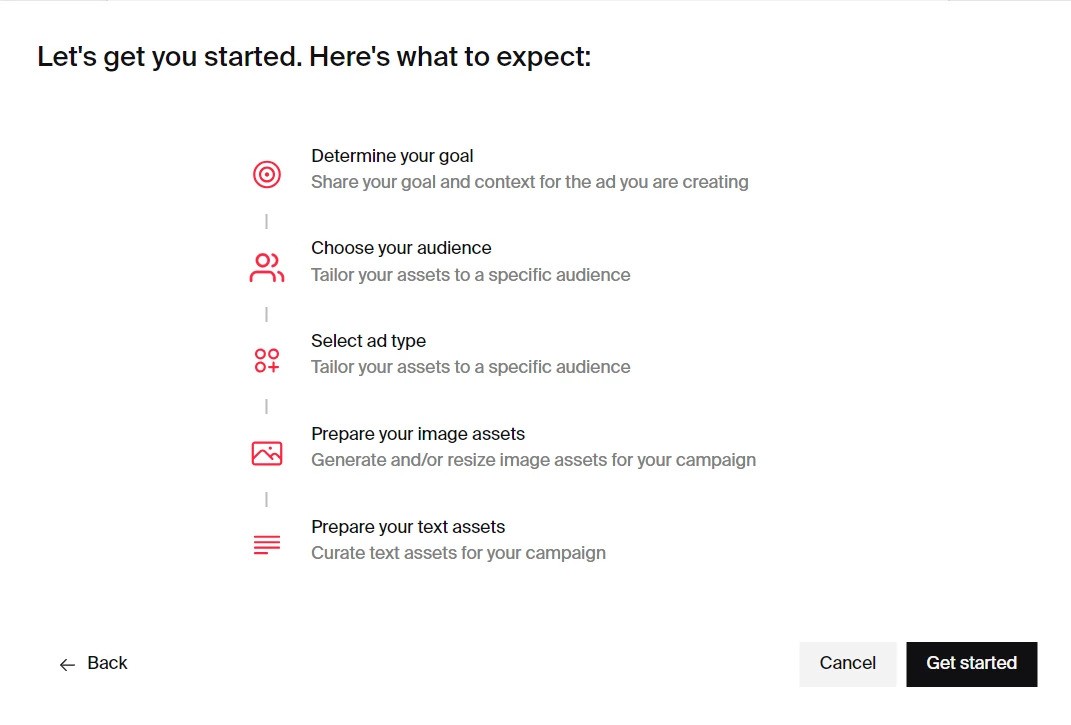
To use this AI template, start by defining your goal, then choose your target audience and either add or generate your product assets for the Facebook ad. You'll also have the option to choose the type of Facebook ad you want to generate, whether it is a single image ad, collection ad, and a carousel ad.
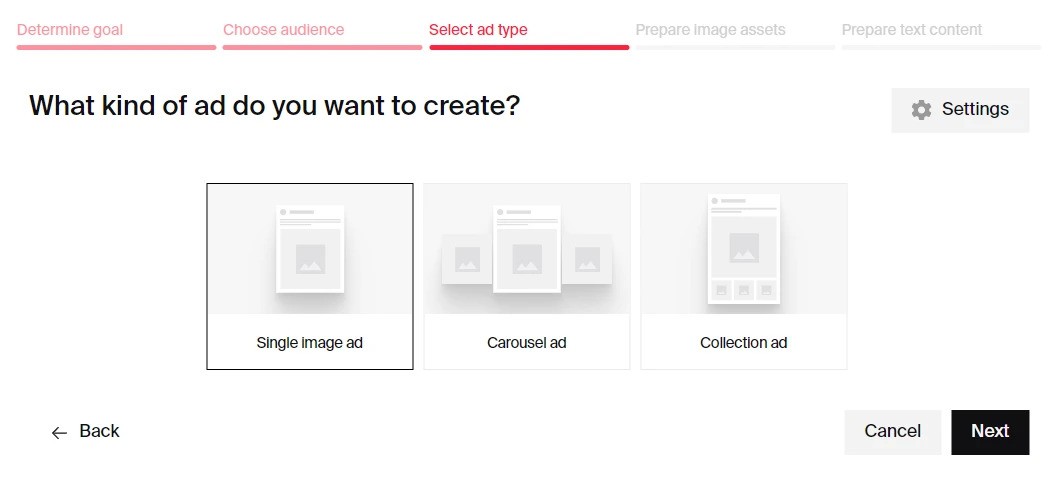
After inputting minimal information about your campaign and target audience, the AI will generate a first draft of your ad copy that's customized for specific audience segments. While you don’t have to provide detailed AI copywriting prompts for ad generation, be sure to include important information and keywords that can help the AI understand your goal with the ad.
💡Tip: Apply your Brand Kit in the settings before generating your Facebook ad to ensure it aligns with your brand guidelines.
Here’s the AI-generated Facebook ad copy we created following the same process:
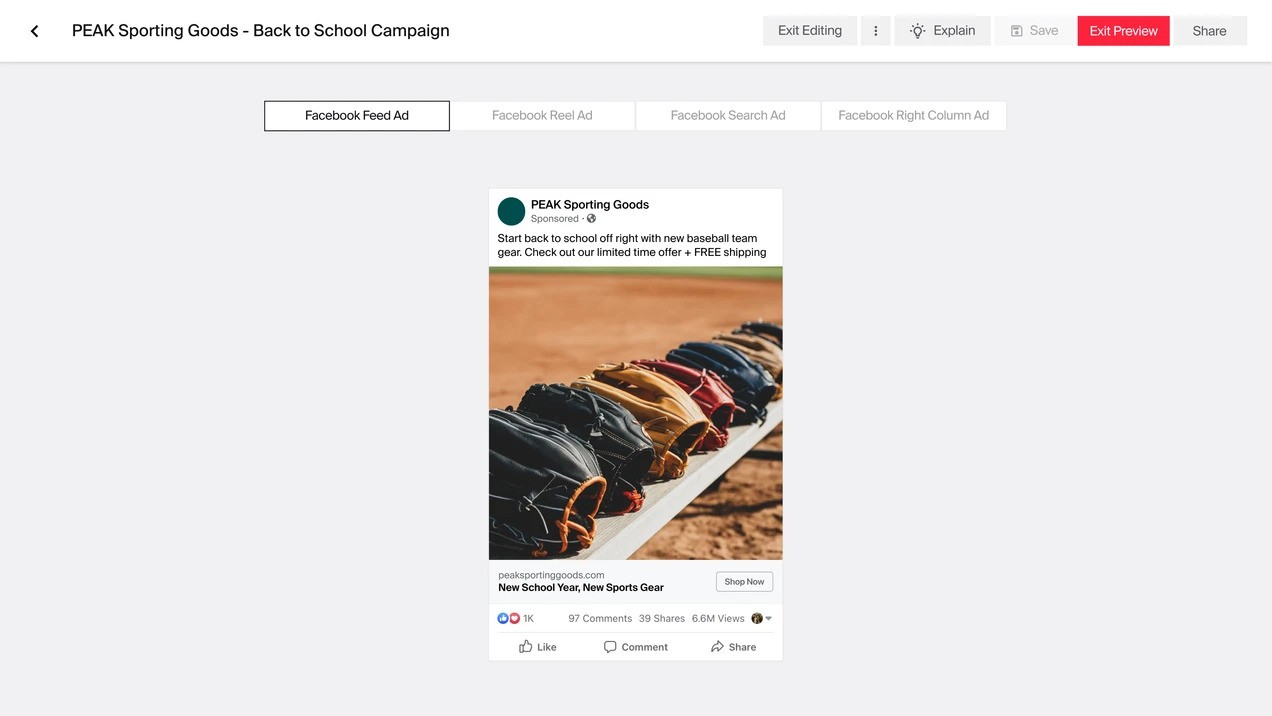
Adapting Facebook ads for multiple channels with Ad Agent
Consider this scenario: Your team has crafted the perfect banner ad for your product launch. But now you need to adapt it for 8 different platforms, translate it into 12 languages, and resize it for 15 different specifications. That's 1,440 variations - and traditional design workflows turn this into a weeks-long process that could delay your entire launch.
Ad Agent eliminates this roadblock, empowering creative teams and brands to multiply their ad campaign assets at scale while maintaining precise control over their design and layout. This means that you can use the same template to create multiple ads, adjusting them to fit different markets and platform specifications, all without manually creating multiple creatives.
Here's how it works:
Import your design templates: Bring your design templates from Figma or Photoshop into Typeface. These will be the foundation for easy adjustments.
Automate creative adaptation: Rather than spending hours adjusting each design, choose a template and let Typeface automatically optimize it for different formats through generative extension and intelligent cropping while preserving key visual elements.
Generate creative variations at scale using pre-loaded brand assets: Upload your content spreadsheet containing pre-approved copy and visuals. The system automatically handles complex layout adjustments – from accommodating longer translations to reformatting entire designs for right-to-left languages, ensuring both text and visuals remain crisp and legible across every variation.
Generate ad variations within saved layouts: If you don't have creatives, you can use your saved design layouts, audience profiles, and brand kits to create custom ad variations that connect with different audiences.
The great thing about this feature is that it allows you to edit multiple creatives at once. With transferable editing, a single change can update an entire campaign. You can easily swap product images while keeping intricate background details intact, update color schemes across formats simultaneously, and use AI to generate new headline variations for your top-performing layouts.
Your path to smarter Facebook ad generation with AI
The demands of creating personalized, high-quality Facebook ad content at scale can overwhelm even the most experienced marketing teams today. But AI ad generators like Typeface are enabling enterprise organizations to maintain both quality and scale – producing thousands of tailored ad variations while ensuring brand consistency and compliance across markets.
By automating time-intensive tasks like creative brief generation, ad copy creation, and multi-channel adaptation, AI empowers marketing teams to focus on strategy and optimization rather than manual content generation. The result is not just greater efficiency, but more engaging ads, reduced ad fatigue, and improved campaign ROI.
So, start your 30-day free Typeface trial or book a demo to get a first-hand experience of the capabilities of this AI content platform.

Share
Related articles

AI at Work
How to Use AI Ad Generators to Create Personalized Ad Campaigns 5x Faster

Neelam Goswami · Content Marketing Associate
November 13th, 2024 · 13 min read

AI at Work
How to Use An AI Social Media Ad Generator to Optimize Ad Spend and Performance

Akshita Sharma · Content Marketing Associate
January 16th, 2025 · 13 min read
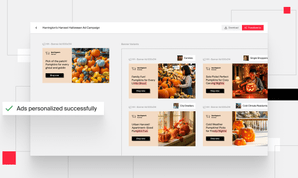
Product
How Creative Teams are Scaling Global Ad Campaigns with 1000+ Assets in Minutes vs. Months

Michal Bloch Ron · Director of Product
November 19th, 2024 · 5 min read